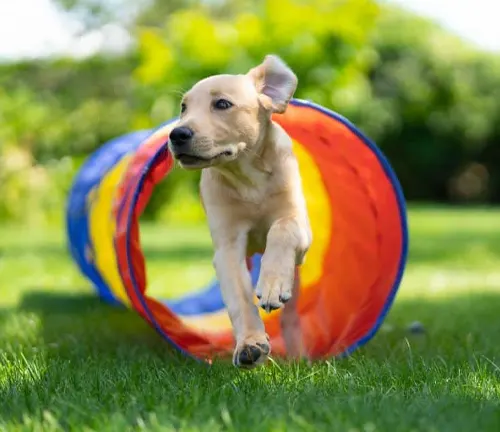Labrador Retrievers Dog
- February 1, 2024
- 0 comment
Labrador Retrievers, often affectionately referred to as “Labradors” or “Labs,” are a highly popular and beloved dog breed worldwide. Renowned for their friendly and outgoing nature, these dogs are cherished for their loyalty and intelligence. Originally bred in Newfoundland, Canada, Labradors were initially known as St. John’s dogs and were valued for their exceptional swimming abilities and work ethic, assisting fishermen in retrieving nets and fish.

Labradors are medium to large-sized dogs with a sturdy and well-balanced build. They sport a short, dense double coat in three primary colors: black, yellow, and chocolate. Beyond their physical attributes, Labradors are celebrated for their gentle temperament and sociable personality. They are known for their patience and tolerance, making them excellent family pets, especially for households with children.

These dogs are not only great companions but also highly trainable. Labradors thrive on positive reinforcement training methods, making them versatile and excelling in various roles, including search and rescue, therapy, and as loyal family pets. To keep them happy and healthy, Labradors require regular exercise, socialization, and proper grooming. With their endearing qualities and unwavering devotion, Labrador Retrievers have rightfully earned their place as one of the most cherished canine companions in the world.
| Characteristic | Description |
|---|---|
| Size | Medium to Large |
| Height (Males) | 22.5 – 24.5 inches |
| Height (Females) | 21.5 – 23.5 inches |
| Coat | Short, Dense Double Coat |
| Coat Colors | Black, Yellow, Chocolate |
| Temperament | Friendly, Outgoing, Gentle |
| Intelligence | Highly Intelligent |
| Compatibility | Excellent with Children and Other Pets |
| Exercise Needs | Active Breed, Requires Regular Exercise |
| Trainability | Highly Trainable with Positive Reinforcement |
| Health | Prone to Hip and Elbow Dysplasia, Obesity |
| Lifespan | Average 10-12 Years |
| Grooming | Regular Brushing and Bathing, Nail Trimming |
| Popularity | One of the Most Popular Dog Breeds Worldwide |

Labrador Retrievers, often simply called Labradors or Labs, are renowned for their friendly and outgoing nature. They are one of the most popular dog breeds worldwide and are cherished for their loyalty and intelligence. Whether you’re a seasoned dog owner or a first-time pet parent, understanding Labrador Retrievers can help you make an informed decision about bringing one into your home.
History of Labrador Retrievers
Labrador Retrievers originated in Newfoundland, Canada, where they were originally known as St. John’s dogs. These canines were initially bred to assist fishermen, helping them retrieve fishing nets and catch fish that escaped from fishing lines. Their excellent swimming abilities and strong work ethic made them invaluable companions to fishermen.

Physical Characteristics

Size and Build
Labradors are medium to large-sized dogs, with males typically standing between 22.5 to 24.5 inches at the shoulder and females slightly smaller at 21.5 to 23.5 inches. They have a sturdy and well-balanced build, with a strong, muscular frame that allows them to excel in various activities.
Coat and Colors
Labradors boast a short, dense double coat that repels water and provides insulation. They are known for their three primary coat colors: black, yellow, and chocolate. Each of these colors has its unique charm, and Labradors of all shades are equally lovable.


Temperament and Personality
One of the standout qualities of Labrador Retrievers is their friendly and sociable nature. They are known for their outgoing personalities, making them excellent family pets. Labradors are also highly intelligent, which allows them to excel in various roles, from search and rescue to therapy dogs.
Labrador Retrievers as Family Dogs
Compatibility with Children
Labradors are often referred to as “gentle giants.” They are known for their patience and tolerance, making them wonderful companions for families with children. Labradors have a playful nature that aligns perfectly with kids’ energy levels.


Interaction with Other Pets
Whether you have other dogs, cats, or smaller pets, Labradors can adapt and coexist harmoniously. Proper socialization and training are essential, but Labradors generally get along well with other animals.
Exercise Needs
Labrador Retrievers are an active breed that requires regular exercise to stay happy and healthy. Daily walks, playtime, and mental stimulation are essential to keep them physically and mentally engaged.

Training and Obedience

Basic Commands
Labradors are highly trainable, and they thrive on positive reinforcement techniques. Teaching them basic commands such as sit, stay, and come can help ensure their safety and your peace of mind.
Socialization
Early socialization is crucial to help Labradors develop good behavior and manners. Exposure to different people, places, and situations will help them grow into well-rounded dogs.
Health and Common Issues
Common Health Problems
While generally healthy, Labradors can be prone to certain health issues, including hip dysplasia, elbow dysplasia, and obesity. Regular veterinary check-ups and a balanced diet can help mitigate these risks.
Preventative Care
Proactive measures like proper nutrition, exercise, and maintaining a healthy weight can go a long way in keeping your Labrador in top condition. Regular grooming and dental care are also important aspects of their overall well-being.

Feeding and Nutrition
Diet Recommendations
Labrador Retrievers have hearty appetites, but it’s important to provide them with high-quality dog food that meets their nutritional needs. Consult your veterinarian for specific feeding guidelines based on your dog’s age, size, and activity level.

Portion Control
Labradors can be prone to overeating, so it’s essential to measure their food portions and avoid free-feeding. This helps maintain a healthy weight and reduces the risk of obesity-related health problems.
Grooming and Maintenance


Brushing and Bathing
Regular brushing helps keep your Labrador’s coat in good condition and minimizes shedding. Bathing should be done as needed, typically every few months or when they get dirty.
Nail Trimming
Regular nail trimming prevents discomfort and potential injuries. If you’re unsure how to trim your Labrador’s nails, consider seeking guidance from a professional groomer or veterinarian.
Labrador Retriever Accessories
Enhance your Labrador’s comfort and style with accessories like collars, leashes, and dog beds. These items not only serve a functional purpose but also allow you to express your dog’s personality.
Labrador Retrievers in Pop Culture
Labradors have a significant presence in pop culture, appearing in movies, TV shows, and advertisements. Their friendly and lovable nature has made them a favorite choice for various roles, leaving a lasting mark on the entertainment industry.

Different Species
Black Labrador Retrievers
These Labradors have a solid black coat, and black is the most common and widely recognized color within the breed.


Yellow Labrador Retrievers
Yellow Labradors can range in color from pale cream to fox red. Their coat can vary in shades of yellow, but they are characterized by their yellowish hues.
Chocolate Labrador Retrievers
Chocolate Labradors have a rich, brown-colored coat that can vary from lighter to darker shades of brown. They are known for their distinctive chocolate-colored fur.

Frequently Asked Question (FAQs)
- Are Labrador Retrievers good with children?
Yes, Labradors are known for their gentle and friendly nature, making them excellent companions for kids. - How much exercise do Labrador Retrievers need?
Labradors are an active breed and require at least 30-60 minutes of exercise daily to stay healthy and happy. - Do Labradors shed a lot?
Labradors do shed, but regular brushing can help minimize shedding and keep their coat in good condition. - Are Labradors easy to train?
Yes, Labradors are highly trainable and respond well to positive reinforcement training methods. - What is the lifespan of a Labrador Retriever?
The average lifespan of a Labrador Retriever is 10 to 12 years, although some can live longer with proper care. - Do Labradors get along with other dogs and pets?
With proper socialization, Labradors generally get along well with other dogs and pets in the household. - How big do Labrador Retrievers get?
Labradors are medium to large-sized dogs, with males typically standing 22.5 to 24.5 inches at the shoulder and females slightly smaller. - Are Labradors good guard dogs?
Labradors are known for their friendly and sociable nature, so they are not typically used as guard dogs. However, they can alert their owners to unusual activity. - What is the best diet for a Labrador Retriever?
A balanced diet with high-quality dog food that meets their nutritional needs is ideal. Consult your veterinarian for specific recommendations. - Do Labradors have any common health issues?
Labradors can be prone to hip dysplasia, elbow dysplasia, and obesity. Regular veterinary check-ups are important to monitor their health. - Can Labradors live in apartments?
While Labradors can adapt to apartment living, they require regular exercise and outdoor activities. A house with a yard is often more suitable. - Are Labradors good swimmers?
Yes, Labradors are exceptional swimmers, thanks to their water-resistant coat and natural swimming ability. - Do Labradors bark a lot?
Labradors are not known to be excessive barkers, but they may bark to alert you to visitors or unusual sounds. - Are Labradors prone to separation anxiety?
Labradors can experience separation anxiety if left alone for extended periods. Proper training and gradual introductions to being alone can help. - Are Labradors good for first-time dog owners?
Yes, Labradors can be a good choice for first-time dog owners due to their friendly and trainable nature, but they do require commitment and proper care.














Leave your comment